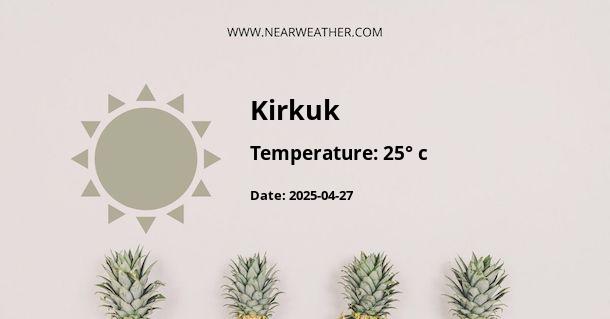Overview of Muḩāfaz̧at Kirkūk, IQ
Muḩāfaz̧at Kirkūk, commonly known as Kirkuk, is a unique location in Iraq that boasts a rich historical background. It is situated in the northeastern part of the country and has an intriguing climate that shapes its lifestyle and activities.Climate of Muḩāfaz̧at Kirkūk
The climate of Kirkuk is characterized as a hot desert (BWh) according to the Köppen-Geiger climate classification. The city witnesses the extremes of temperatures with a considerable difference between the summer and winter months. The year-round weather can be broadly categorized into the hot season and the cool season.
The Hot Season
The hot season in Kirkuk typically lasts from June to September with an average daily high temperature above 37°C. The hottest month of the year is July, with an average high of 41°C and low of 26°C. The residents of Kirkuk experience scorching heat during these months with the sky being mostly clear.
During the hot season, the temperatures in Kirkuk can reach extreme highs, contributing to the desert climate of the region.
The Cool Season
The cool season lasts for about 3.4 months, from November 26 to March 7, with an average daily high temperature below 17°C. The coldest month is January, with an average low of 3°C and high of 15°C. The temperatures during the cool season can drop significantly, particularly at night.
Year-round Weather
The weather in Kirkuk varies considerably throughout the year. The city experiences minimal rainfall, with the most rain falling in the month of January. Nevertheless, the city is mostly dry throughout the year.
Wind and Humidity
The wind in Kirkuk is usually from the north, with a peak average hourly wind speed of 15.5 km/h. The city also experiences high humidity, particularly during the cool season, which can add to the chill factor.
Despite the high temperatures during the summer months, the wind and humidity levels in Kirkuk can often make the weather feel more pleasant than the actual temperature readings.
Climate and Lifestyle
The climate in Kirkuk significantly influences the lifestyle and activities of the residents. The hot and dry climate is ideal for certain types of agriculture, such as date farming. During the hot season, outdoor activities are limited due to the high temperatures. However, in the cooler months, residents enjoy outdoor activities such as picnics and visiting local parks.
Climate Change Impact
Like many regions worldwide, Kirkuk is also feeling the impacts of climate change. The rising temperatures and changing rainfall patterns are affecting agricultural activities and water availability in the region.
Climate change is a serious concern for Kirkuk and could have far-reaching impacts on the region's economy and lifestyle.
Conclusion
The climate and weather patterns in Kirkuk play a significant role in shaping the region's lifestyle and activities. Understanding these patterns can provide valuable insights into the local culture and economy. However, the looming threat of climate change is a serious concern and requires proactive measures to mitigate its impacts.
References
- Climate-Data.org. (n.d.). Climate Kirkuk: Temperature, climate graph, Climate table for Kirkuk - Climate-Data.org.
- World Weather Online. (n.d.). Kirkuk Monthly Climate Averages.
- Weather Spark. (n.d.). Average Weather in Kirkuk, Iraq, Year Round - Weather Spark.
A - Kirkuk's Latitude is 35.250000 & Longitude is 44.166672.
A - Weather in Kirkuk is 19° today.
A - Climate Conditions in Kirkuk shows clear sky today.
A - Humidity in Kirkuk is 33% today.
A - Wind speed in Kirkuk is 18.36 km/h, flowing at 354° wind direction. today.
